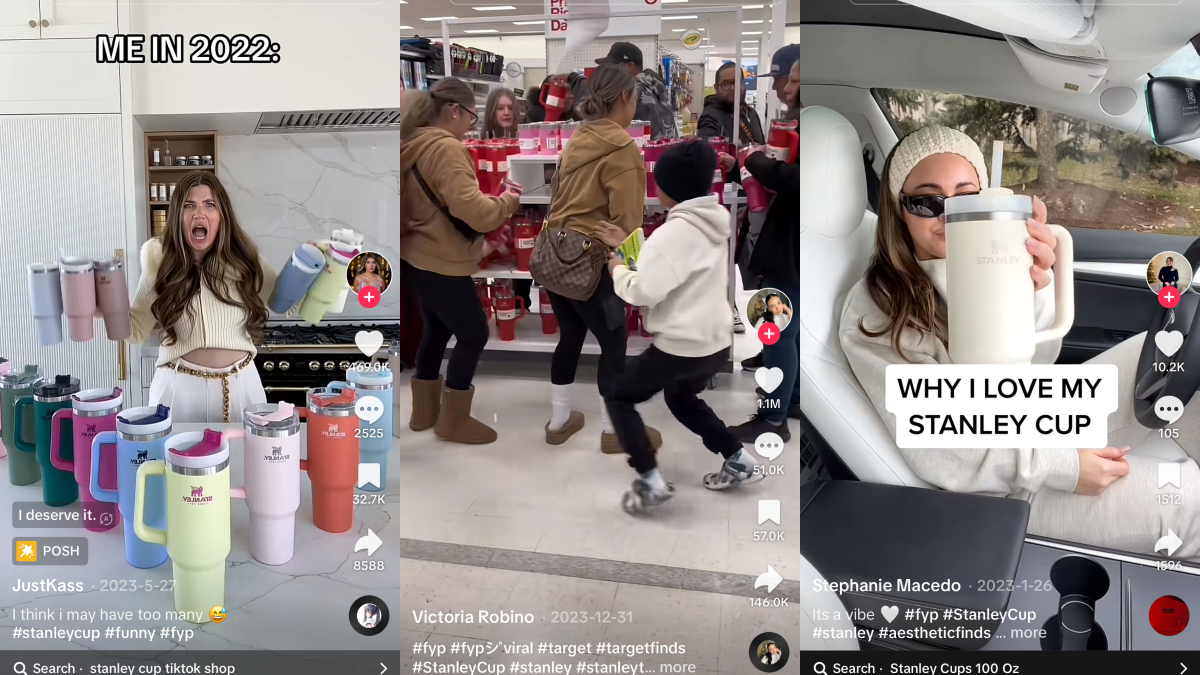Entertainment
What’s so special about a Stanley cup? A guide to conspicuous consumption on TikTok.

Last week, people at Target nearly bloodied each other as they fought to get one of the new, special-edition Valentine’s Day cups from Stanley, a company known for its TikTok-famous tumblers.
Stanley is a good tumbler. It keeps your hot drinks hot and your cold drinks cold, even in a burning car. But it isn’t “commit an act of violence” good, and there are a lot of tumblers that do it better. So why are we so obsessed with them that we’re willing to camp out in front of a Target to buy them in Cosmo pink?
It’s partly due to the scarcity effect, according to a New York Times piece on the phenomenon. The tumbler is a fashion item, and exclusive colors are only available for a short amount of time, making people more inclined to buy them when they drop. But TikTok is also a huge piece of the puzzle.
After gaining some attention from an Instagram blog, the Quencher, Stanley’s 40-ounce tumbler, became the It-item on the app, with people showing off their collections of Stanley tumblers which take up entire walls in their homes and sharing affiliate links to accessories for their cups. If TikTok users didn’t already have one before Christmas, they likely had it on their lists. And each tumbler is around $50, making them expensive for a cup but still attainable for most shoppers.
The frenzy for the tumblers points to a sensation becoming all too popular on TikTok: The app makes us feel insecure and uncertain of ourselves, and those very insecurities and uncertainties are being exploited for spending power.
Spending to be seen
The Stanley tumbler has become a $50 status symbol, as the Wall Street Journal pointed out, usurping the status symbols of yore: Jimmy Choo shoes and Armani suits. It points to a rise in a centuries-old trend with a new twist fueled by social media: conspicuous consumption.
Conspicuous consumption — a term coined by economist Thorstein Veblen that describes the act of buying something specifically to show off your economic or social status — is not new, but is most often associated with the upper class who have an abundance of disposable income. It’s like someone who isn’t particularly interested in collecting watches spending thousands of dollars on a Rolex instead of a Timex that has the same functionality. And, as @resumeofficial on TikTok pointed out, “We as the middle class took [conspicuous consumption] and adjusted it” despite not having the same kind of privilege for spending.
Partially, this is because wealth inequality has moved us away from seeing luxury products as aspirational — and some of that aspiration was replaced by parasocial relationships that encourage us all to spend on anything the influencers we see own. Not all of them accumulate luxury products, but a lot of them have smaller in-demand items like Stanleys.
“Many parasocial relationships between online content creators and their audiences is based on aspiration,” Ali Fazal, the Vice President of Marketing at GRIN, told Mashable. “Consumers have always been fascinated by the lifestyles of those they follow, but in 2024, instead of those subjects being athletes or major celebrities, they are often influencers and online content creators whose lifestyles seem more within reach. As a result, being able to share products, goods, or services that someone you aspire to be like also deepens the connection.”
The Stanley tumbler was quietly advertised to you through TikTok, but not all of those videos were ads. Instead, a few influencers posted about liking them, and the trend snowballed. One study from Binus University showed that there is a direct link between TikTok usage and conspicuous consumption, fueled by a “bandwagon effect.” As the Association for Consumer Research points out, “this effect is an attempt to ‘keep up with the Joneses’ in order to preserve one’s self-esteem.”
You’re willing to spend $50 on a Stanley cup instead of $20 on a Hydro Flask, which tends to perform at a higher level with regards to keeping the temperature of your drink consistent, because of what it symbolizes. You want the Stanley so other people know you’re in the know; you are in their same social status; you can afford to spend $50 on a cup; you are the hottest mom on the soccer field and the most desirable vet tech in the office. According to research from Lending Tree, nearly 40 percent of Americans have overspent on clothes, shoes, and accessories — like the Stanley tumbler — to impress others. And in 2022, social media apps made $11 billion from children and teens. The TikTok algorithm feeds us videos that make us feel uncertain and insecure in our lives, showing us something to buy to better fit in or fit a certain ideal.
Buying our way out of uncertainty
In a study in the National Library of Medicine, “The link between self-uncertainty and conspicuous consumption: Tolerance of uncertainty as a moderator,” researchers found that people who are uncertain of themselves were more likely to engage in this kind of spending and that people who are less comfortable being uncertain about themselves are even more likely to engage in conspicuous consumption.
While conspicuous consumption isn’t new, the way we interact with it is. Fazal said that one of the more significant changes to conspicuous consumption has been that “consumer attention follows influencers now more than anyone else, and as a result, social networks are where this trend is displayed the most.” We’re no longer trying to fit in with our close-knit community — we’re trying to fit in with a community of thousands of people online. TikTok is changing the way we think about ourselves, and how much money we’re willing to spend to prove it.
And these trends might be picking up speed. Urvashi Ajmera, senior strategist at digital agency Barbarian, told Digiday that TikTok Shop will transform the experience we have on social media even more than it already has.
“More and more organic content will have the Shop feature, and you’d be scrolling through an infinite feed of shop and sponsored content,” Ajmera said.
Social media will only get better at convincing us we need to spend money on stuff to fit in, enjoy life, or inch closer to morphing into our favorite influencer. And the trends will shift.
Now that Stanley tumblers are so popular, consumer trends analysts are predicting that we’re all going to hate them soon — and the Stanley obsession will inevitably be replaced with something new that you’ll be convinced to buy, too. The cycle always continues, but it’s getting more difficult to determine what is being advertised to us and the real motivations behind our purchases.
Be careful what your mind does on social media; before you know it, you might reach for your wallet.
-

 Business6 days ago
Business6 days agoTesla’s new growth plan is centered around mysterious cheaper models
-

 Business7 days ago
Business7 days agoUnitedHealth says Change hackers stole health data on ‘substantial proportion of people in America’
-

 Business5 days ago
Business5 days agoXaira, an AI drug discovery startup, launches with a massive $1B, says it’s ‘ready’ to start developing drugs
-

 Business5 days ago
Business5 days agoUK probes Amazon and Microsoft over AI partnerships with Mistral, Anthropic, and Inflection
-

 Entertainment3 days ago
Entertainment3 days agoSummer Movie Preview: From ‘Alien’ and ‘Furiosa’ to ‘Deadpool and Wolverine’
-

 Business4 days ago
Business4 days agoPetlibro’s new smart refrigerated wet food feeder is what your cat deserves
-

 Business6 days ago
Business6 days agoTwo widow founders launch DayNew, a social platform for people dealing with grief and trauma
-

 Entertainment6 days ago
Entertainment6 days agoTesla’s in trouble. Is Elon Musk the problem?




























